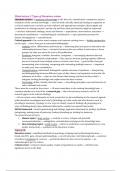Video lecture 1: Types of literature review
Literature review = a synthesis of knowledge in the form of a classification, comparison and/or
evaluation of the current knowledge → need to think critically about (a) forming an argument or
a critical analysis you can back up with evidence and appropriate examples, (b) strengths and
weaknesses of existing research, and (c) why and how ideas and theories might be improved.
→ involves: substantive findings, issues and themes -> populations, interventions, outcomes ->
theoretical contributions -> methodological contributions -> open questions (avenues for
further investigation) -> contradictions.
Critical approach = the review must compare and contrast existing views → holistic perspective
on the topic → more than just an annotated bibliography.
- Analysis: select, differentiate and break up → dissecting data into parts to determine the
relationship between them → instead of primary data you collect in interviews or focus
groups, the data you use is the text in the publication.
- Synthesis: integrate, combine, formulate, reorganise → rearranging elements derived
from analysis to identify relationships → like a puzzle, because putting together different
pieces of research from multiple sources to form a new story → goes farther than just
summarising, also criticising, comparing and contrasting multiple sources → important
to make your own contribution.
- Comprehension: understand, distinguish, explain outcome of synthesis → interpreting
and distinguishing between different types of data, theory and argument to describe the
substance of an idea → what are the themes that emerge and how do they relate? →
integrate existing knowledge and explain what has been written.
- Knowledge: define, classify, describe, name → describing principles, uses and function of
rules, methods and events.
There must be a need for the review → LR must contribute to the existing knowledge base →
common mistake is to search for a research gap → this is for primary research, but for LR
research gaps can be relevant findings.
→ LR can create a new dimension or fresh perspective by: (a) contributing to the research agenda
(what should be investigated and why?), (b) finding out what works and what doesn’t work, (c)
providing a taxonomy, typology or new ways to classify research findings, (d) proposing new
ways of thinking about topics addressed (alternative model/conceptual framework).
SALSA framework = Search (questioning and finding), AppraisaL (assessing for quality), Synthesis
(integrating, making sense of patterns), Analysis (breaking up, looking for patterns).
Two general kinds of topics:
1. Mature topics = large corpus → need for a review, critique and potential
reconceptualization → ambiguities, contradictions and gaps in the knowledge base.
2. New/emerging topics = small corpus → initial or preliminary conceptualisation (i.e. new
model, framework) → synthesis of the literature to date.
Types of LR:
Narrative review = undefined methods of searching, critiquing and synthesising literature →
broad aim (FEX. gain a broad understanding) → no well structure, but following leads → selection
of studies is purposive by reviewer → performed based on the reviewer’s opinion → no
methodological part is written.
Critical review = critical evaluate quality, results in hypothesis or model → identify most
significant items in the field.
, Integrative review = broadest type of review, includes experimental and non-experimental
research, may combine theoretical and empirical data → comprehensive search to identify
maximum primary sources → purposive sampling.
Mapping review = map and categorize existing literature to plan further reviews and/or
research by identifying gaps → determined by time/scope constraints.
Mixed methods = combination of review approaches → FEX. combining quantitative with
qualitative research → sensitive search or combining quantitative and qualitative strategies.
Overview = summary of literature that attempts to survey data and describe its characteristics
→ may include comprehensive searching.
Scoping review = assessment of potential size and scope of available research literature →
identify nature and extent of research evidence (usually including ongoing research) →
determined by time/scope constraints.
State-of-the art review = addresses more current matters, may offer new perspectives on issues
or point out areas for further research.
Systematic review = explicit, rigorous method of searching, critiquing and synthesising
literature → narrow focus, specific review focus → strict protocol to include as much studies in
the review as possible → follow predetermined criteria for including and excluding studies →
methodological part for transparency and reproductivity → key phases:
1. Mapping the field through a scoping review → what are knowledge gaps, preparing review
plan → method and protocol, defining questions and keywords, setting up inclusion and
exclusion criteria.
2. Comprehensive search → search using keywords and document search results in a table
→ maybe need to revise inclusion and exclusion criteria or research question.
3. Quality assessment → read the full paper and apply quality assessment, using the
hierarchy of research → decide which papers are in and out of the review.
4. Data extraction → write relevant data down in an extraction sheet.
5. Synthesis → synthesis data from individual articles into one.
6. Write up → balanced, impartial and comprehensive
report, using a format, while enabling other researchers to
replicate the review.
→ hierarchy of research (picture left) = hierarchy of study types
→ systematic review is at the top.
Meta-analysis = combines the results of quantitative studies →
comprehensive searching.
Key dimensions on which reviews differ: picture right →
- configurative = interpret and
understand a topic, arranging info and developing rather than applying
concepts → generate theory (seeking concepts).
- aggregative = collecting empirical data to describe and test definite
concepts, follow a logic, because they are adding up to make empirical
statements → test theory (seeking evidence to inform decision making).
Systematic review vs. systematic approach: systematic review follow strict
protocol → systematic approach = identify, critically appraise and synthesize
relevant studies to answer a predefined question → comprehensive searching
strategy, developing inclusion and exclusion criteria → critical appraisal to ensure that only high
quality papers are included → the findings of all the papers are then pulled together and
combined using a systematic approach.





